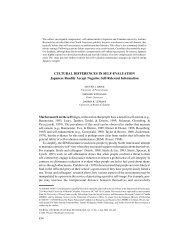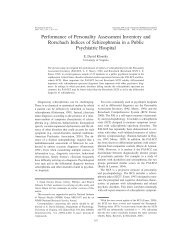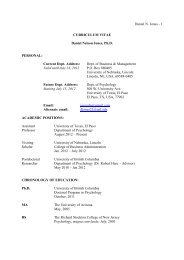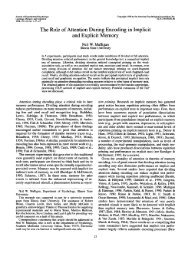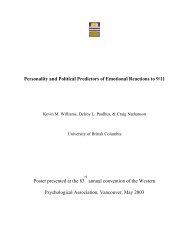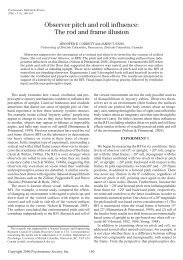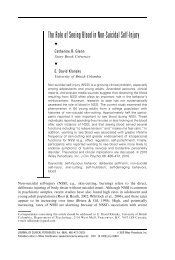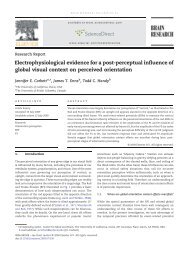Dynamic Social Impact and the Evolution of Social Representations ...
Dynamic Social Impact and the Evolution of Social Representations ...
Dynamic Social Impact and the Evolution of Social Representations ...
Create successful ePaper yourself
Turn your PDF publications into a flip-book with our unique Google optimized e-Paper software.
Journal <strong>of</strong> Communication, Autumn 1996<br />
sources. Similarly, different stereotypes <strong>of</strong> any single group might also be<br />
viewed as being in competition-competition for lasting representation in individual<br />
minds <strong>and</strong> across <strong>the</strong> social l<strong>and</strong>scape. For example, <strong>the</strong> stereotype <strong>of</strong><br />
women as weak, submissive, <strong>and</strong> irrational is in competition with <strong>the</strong> belief that<br />
women can be at least as strong, assertive, <strong>and</strong> sensible as men. We might underst<strong>and</strong><br />
variations <strong>and</strong> change in cultural stereotypes as responsive to competitive<br />
dynamics similar to those underlying biological ecosystems.<br />
For instance, it appears that in many bounded ecosystems, population sizes<br />
<strong>of</strong> competing species fluctuate around some equilibrium (MacArthur & Wilson,<br />
1967). As <strong>the</strong> population size <strong>of</strong> one species grows <strong>and</strong> <strong>the</strong> size <strong>of</strong> a competing<br />
species decreases, certain environmental constraints conspire to reverse those<br />
trends. Consequently, <strong>the</strong> less populous species gains numbers while <strong>the</strong> more<br />
populous species decreases in size. This trend continues until environmental<br />
pressures act once again to reverse <strong>the</strong>se trends. Analogous dynamics may govern<br />
fluctuations in <strong>the</strong> “population size” <strong>of</strong> stereotypes. For instance, as a negative<br />
stereotype <strong>of</strong> women becomes increasingly common, <strong>and</strong> a positive perception<br />
rare, <strong>the</strong> remaining individuals holding <strong>the</strong> minority perspective are<br />
likely to be those who most strongly hold that perspective. As a result, <strong>the</strong>y are<br />
likely to be more able <strong>and</strong> motivated to defend that perspective, <strong>and</strong> to convince<br />
o<strong>the</strong>rs that <strong>the</strong>ir perspective is true. Status as a less-populous cultural stereotype<br />
precipitates certain communicative <strong>and</strong> persuasive advantages that help<br />
to replicate that stereotype across <strong>the</strong> social l<strong>and</strong>scape. Ra<strong>the</strong>r than reaching a<br />
point <strong>of</strong> static equilibrium, <strong>the</strong> distribution <strong>of</strong> stereotypic beliefs-like biological<br />
populations-may fluctuate around an equilibrium.<br />
Succession<br />
Finally, consider <strong>the</strong> dynamics <strong>of</strong> species succession within ecosystems. Over<br />
time, <strong>the</strong>re is greater turnover in <strong>the</strong> number <strong>and</strong> type <strong>of</strong> species colonizing a<br />
favorable, resource-rich environment (e.g., a forest) than in <strong>the</strong> species colonizing<br />
a harsh environment (e.g., a desert). As a result, <strong>the</strong> “climax community” in<br />
a harsh environment may be little different from <strong>the</strong> community <strong>of</strong> original biological<br />
colonizers; in contrast, <strong>the</strong> climax community in a favorable environment<br />
rarely consists <strong>of</strong> <strong>the</strong> original colonizers (MacArthur & Connell, 1966). The distinction<br />
between favorable <strong>and</strong> harsh environments may also apply to <strong>the</strong> social<br />
environments within which cultural stereotypes clash for acceptance <strong>and</strong> survival.<br />
Certain social environments are rich in <strong>the</strong> communication-based resources<br />
that sustain <strong>and</strong> fertilize novel, rare, or unpopular beliefs about groups<br />
(e.g., freedom <strong>of</strong> speech, legally protected tolerance <strong>of</strong> alternative beliefs, <strong>and</strong><br />
access to unregulated mass media). Harsher environments may tolerate fewer<br />
species <strong>of</strong> stereotypes in general, <strong>and</strong> <strong>the</strong>re may be little or no change over<br />
time in <strong>the</strong> dominant cultural stereotypes.<br />
This line <strong>of</strong> reasoning <strong>of</strong>fers a moderating perspective on sociological models<br />
hypo<strong>the</strong>sizing that cultures progress through certain stages <strong>of</strong> change in <strong>the</strong> acceptance<br />
<strong>of</strong> ethnic minority groups (e.g., Blumer, 1965; Kleinpenning &<br />
Hegendoorn, 1993). Such models imply gradual extinction <strong>of</strong> negative stereotypes<br />
<strong>of</strong> minority groups. The ecosystem analogy suggests that stage models<br />
70



